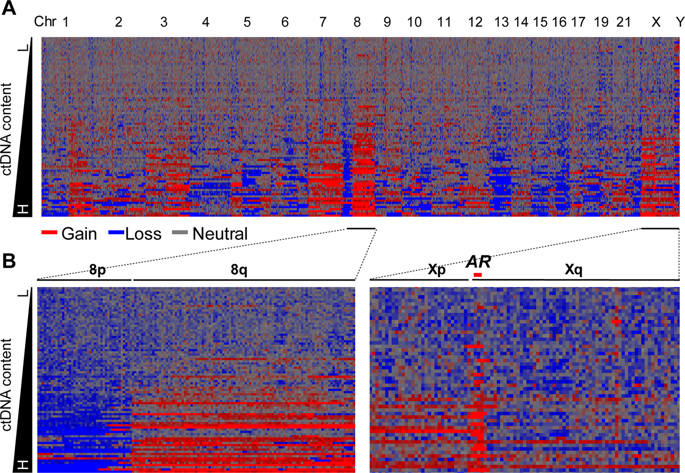当前位置:
X-MOL 学术
›
Prostate Cancer Prostatic. Dis.
›
论文详情
Our official English website, www.x-mol.net, welcomes your feedback! (Note: you will need to create a separate account there.)
Plasma cell-free DNA-based predictors of response to abiraterone acetate/prednisone and prognostic factors in metastatic castration-resistant prostate cancer.
Prostate Cancer and Prostatic Diseases ( IF 4.8 ) Pub Date : 2020-03-18 , DOI: 10.1038/s41391-020-0224-4 Meijun Du 1 , Yijun Tian 1 , Winston Tan 2 , Liewei Wang 3 , Liguo Wang 4 , Deepak Kilari 5 , Chiang-Ching Huang 6 , Liang Wang 1, 7 , Manish Kohli 8
Prostate Cancer and Prostatic Diseases ( IF 4.8 ) Pub Date : 2020-03-18 , DOI: 10.1038/s41391-020-0224-4 Meijun Du 1 , Yijun Tian 1 , Winston Tan 2 , Liewei Wang 3 , Liguo Wang 4 , Deepak Kilari 5 , Chiang-Ching Huang 6 , Liang Wang 1, 7 , Manish Kohli 8
Affiliation

|
BACKGROUND
The combination of abiraterone acetate and prednisone (AA/P) is used to treat metastatic prostate cancer, but molecular predictors of treatment response are not well elucidated. We evaluated plasma circulating tumor DNA- (ctDNA-) based copy number alterations (CNAs) to determine treatment-related predictive and prognostic biomarkers for metastatic castration-resistant prostate cancer (mCRPC).
METHODS
Serial plasma specimens were prospectively collected from 88 chemotherapy-naive mCRPC patients before and after 12 weeks of AA/P treatment. Sequencing-based CNA analyses were performed on 174 specimens. We evaluated CNA-associated 12-week responses for primary resistance, time to treatment change (TTTC) for secondary resistance, and overall survival for prognosis (P < 0.05). Associations with primary resistance were analyzed using the Fisher exact test. Kaplan-Meier survival curves and Cox regression analyses were used to determine the associations of CNAs with acquired resistance and overall survival.
RESULTS
ctDNA reduced by 3.89% in responders and increased by 0.94% in nonresponders (P = 0.0043). Thirty-one prostate cancer-related genes from whole genome CNAs were tested. AR and AR enhancer amplification were associated with primary resistance (P = 0.0039) and shorter TTTC (P = 0.0003). ZFHX3 deletion and PIK3CA amplification were associated with primary resistance (P = 0.026 and P = 0.017, respectively), shorter TTTC (P = 0.0008 and P = 0.0016, respectively), and poor survival (P = 0.0025 and P = 0.0022, respectively). CNA-based risk scores combining selected significant associations (AR, NKX3.1, and PIK3CA) at the univariate level with TTTC were predictive of secondary resistance (P = 0.0002). and established prognoses for survival based on CNAs in ZFHX3, RB1, PIK3CA, and OPHN1 (P = 0.002). Multigene risk scores were more predictive than individual genes or clinical risk factors (P < 0.05).
CONCLUSION
Plasma ctDNA CNAs and risk scores can predict mCRPC-state treatment and survival outcomes.
中文翻译:

基于血浆无细胞 DNA 的醋酸阿比特龙/泼尼松反应的预测因子和转移性去势抵抗性前列腺癌的预后因素。
背景 醋酸阿比特龙和泼尼松 (AA/P) 的组合用于治疗转移性前列腺癌,但尚未很好地阐明治疗反应的分子预测因子。我们评估了基于血浆循环肿瘤 DNA(ctDNA)的拷贝数改变(CNA),以确定转移性去势抵抗性前列腺癌(mCRPC)的治疗相关预测和预后生物标志物。方法 前瞻性收集 88 名未接受过化疗的 mCRPC 患者在 AA/P 治疗 12 周之前和之后的系列血浆标本。对 174 个样本进行了基于测序的 CNA 分析。我们评估了 CNA 相关的 12 周原发耐药反应、继发耐药的治疗变化时间 (TTTC) 和预后的总生存率 (P < 0.05)。使用Fisher精确检验分析与初级抗性的关联。Kaplan-Meier 生存曲线和 Cox 回归分析用于确定 CNA 与获得性耐药和总生存的关联。结果 响应者的 ctDNA 减少了 3.89%,无响应者的 ctDNA 增加了 0.94%(P = 0.0043)。测试了来自全基因组 CNA 的 31 个前列腺癌相关基因。AR 和 AR 增强子扩增与初级抗性 (P = 0.0039) 和更短的 TTTC (P = 0.0003) 相关。ZFHX3 缺失和 PIK3CA 扩增与原发耐药(分别为 P = 0.026 和 P = 0.017)、较短的 TTTC(分别为 P = 0.0008 和 P = 0.0016)和较差的存活率(分别为 P = 0.0025 和 P = 0.0022)相关. 基于 CNA 的风险评分结合了选定的显着关联(AR、NKX3.1、和 PIK3CA) 在单变量水平与 TTTC 预测继发性耐药 (P = 0.0002)。并基于 ZFHX3、RB1、PIK3CA 和 OPHN1 中的 CNA 确定了生存预后(P = 0.002)。多基因风险评分比单个基因或临床风险因素更具预测性(P < 0.05)。结论 血浆 ctDNA CNA 和风险评分可以预测 mCRPC 状态的治疗和生存结果。
更新日期:2020-03-18
中文翻译:

基于血浆无细胞 DNA 的醋酸阿比特龙/泼尼松反应的预测因子和转移性去势抵抗性前列腺癌的预后因素。
背景 醋酸阿比特龙和泼尼松 (AA/P) 的组合用于治疗转移性前列腺癌,但尚未很好地阐明治疗反应的分子预测因子。我们评估了基于血浆循环肿瘤 DNA(ctDNA)的拷贝数改变(CNA),以确定转移性去势抵抗性前列腺癌(mCRPC)的治疗相关预测和预后生物标志物。方法 前瞻性收集 88 名未接受过化疗的 mCRPC 患者在 AA/P 治疗 12 周之前和之后的系列血浆标本。对 174 个样本进行了基于测序的 CNA 分析。我们评估了 CNA 相关的 12 周原发耐药反应、继发耐药的治疗变化时间 (TTTC) 和预后的总生存率 (P < 0.05)。使用Fisher精确检验分析与初级抗性的关联。Kaplan-Meier 生存曲线和 Cox 回归分析用于确定 CNA 与获得性耐药和总生存的关联。结果 响应者的 ctDNA 减少了 3.89%,无响应者的 ctDNA 增加了 0.94%(P = 0.0043)。测试了来自全基因组 CNA 的 31 个前列腺癌相关基因。AR 和 AR 增强子扩增与初级抗性 (P = 0.0039) 和更短的 TTTC (P = 0.0003) 相关。ZFHX3 缺失和 PIK3CA 扩增与原发耐药(分别为 P = 0.026 和 P = 0.017)、较短的 TTTC(分别为 P = 0.0008 和 P = 0.0016)和较差的存活率(分别为 P = 0.0025 和 P = 0.0022)相关. 基于 CNA 的风险评分结合了选定的显着关联(AR、NKX3.1、和 PIK3CA) 在单变量水平与 TTTC 预测继发性耐药 (P = 0.0002)。并基于 ZFHX3、RB1、PIK3CA 和 OPHN1 中的 CNA 确定了生存预后(P = 0.002)。多基因风险评分比单个基因或临床风险因素更具预测性(P < 0.05)。结论 血浆 ctDNA CNA 和风险评分可以预测 mCRPC 状态的治疗和生存结果。



























 京公网安备 11010802027423号
京公网安备 11010802027423号